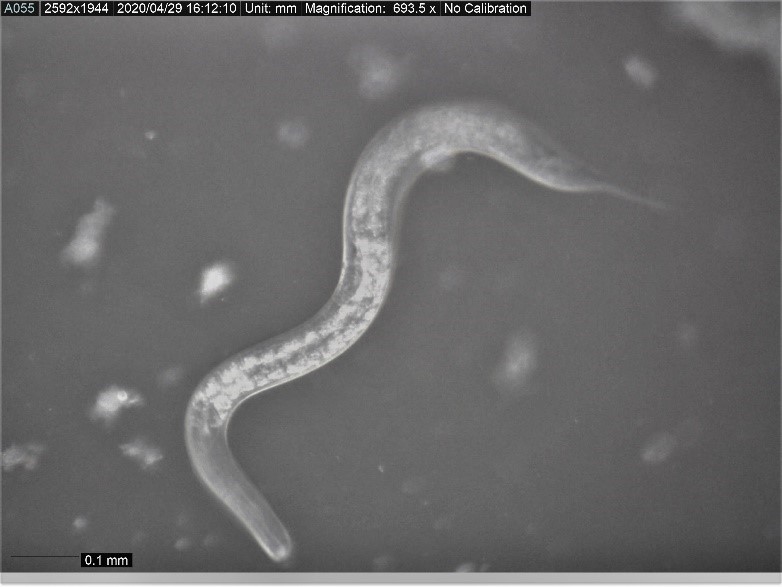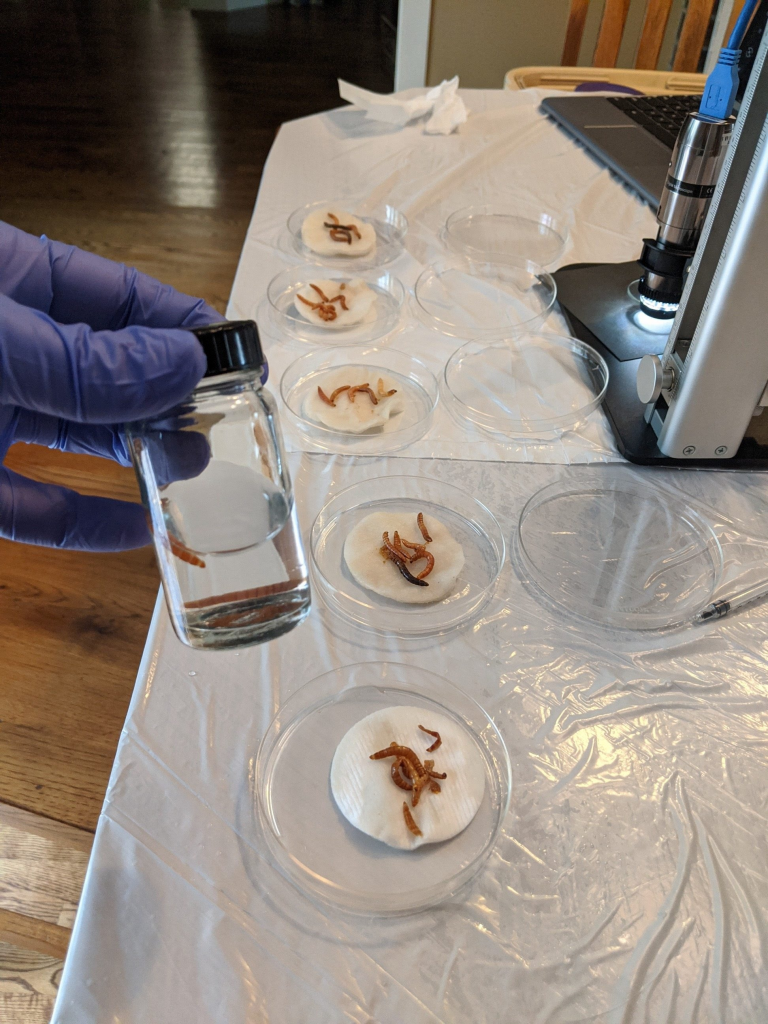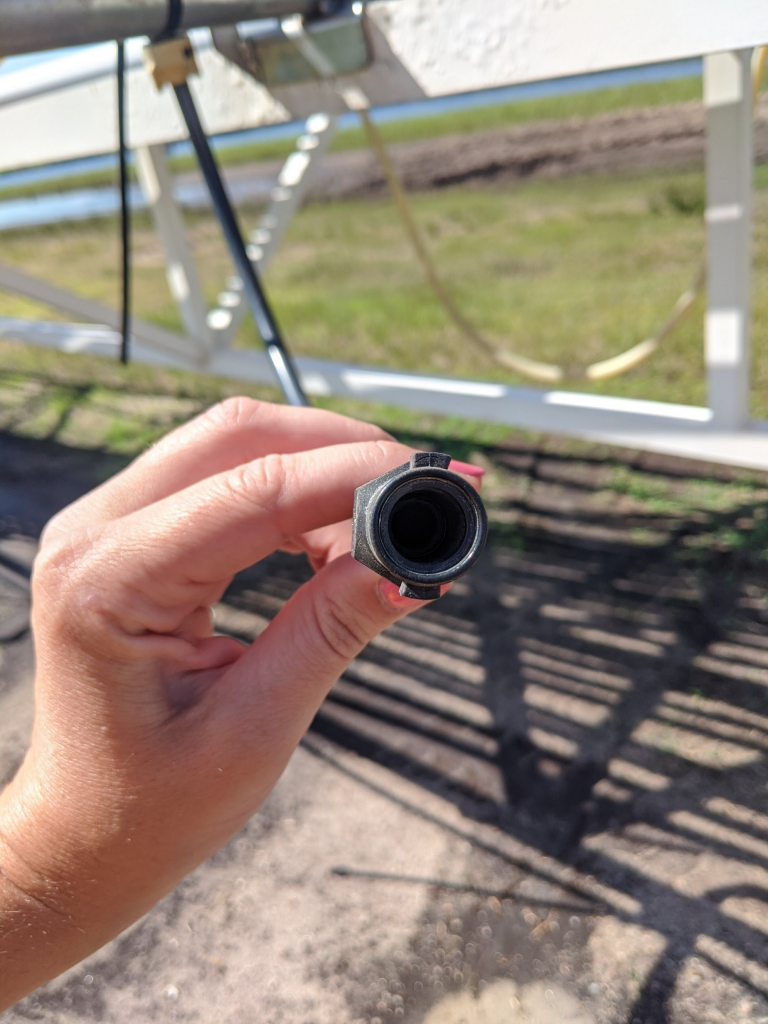Hungry Nematodes in Wisconsin Cranberry Marshes

The native Wisconsin nematode species, Oscheius onirici (pronounced OSS-key-us on-a-REACH-ē), also known as just “Oskie,” is a highly virulent bio-control agent for control of cranberry pests of all kinds. This nematode was originally found in the wild marshlands of central Wisconsin, and it kills everything we’ve thrown at it. To-date, any insect we’ve screened against Oskie has been killed. Importantly, the nematode readily kills flea beetle, sparg, and girdler larvae. It also kills white grubs, various caterpillars, fruit flies, and mosquitoes.
The way the nematode kills is by entering the host insect through the various openings in the insect larva’s body. Then the nematode deploys its payload, which is a mass of bacteria. The bacteria then start a massive infection, killing the insect. The bacteria continue to propagate and basically liquify the insides of the insect cadaver. This liquified, bacteria-rich goo is the nematode’s favorite food. Literally, the nematode “farms” the bacteria within the body of the insect, and when the insect is dead and the bacteria have eaten the insides of the cadaver, the nematodes squirm through and eat up the bacteria. The nematodes turn a few generations within the cadaver and then emerge to hunt new insect hosts. In the past, we’ve seen 60+% mortality of flea beetles in August, following a nematode soil-soak in late June. So, this native WI animal represents a promising bio-control agent—it’s a broad-spectrum bio-insecticide. A slurry of the nematodes can be thrown into the spray tank and applied through a boom-sprayer system.
A Citizen Science project has been initiated in which growers and pest management consultants are working on a new, viable way to mass-propagate the nematodes. This work has been spearheaded by Pam Verhulst, of LadyBug IPM.
It’s easy to grow hundreds of thousands of nematodes on the countertop, but it’s a very different proposition to grow hundreds of millions. It’s also difficult to store and transport the nematodes without seeing significant mortality. The nematodes like to live in the soil, and they are killed easily in the sunlight or when they dry up. So, we need to get them from the fermentation tank to the soil without causing them much trauma. That has been very difficult. Our mass-propagation system is still in development, as described by Pam below:
We have come a long way from a seeing our very first nematode under the microscope to having too many to count!
To start our populations Shawn left each of us with a small vial of infected mealworms. From that we separated them into petri dishes and waited. Only a couple of the petri dishes were able to produce more nematodes. Shawn sent each of us more vials full of mealworms and nematodes. We learned a few lessons on how to better package vials with live nematodes and the cooperators finally received some viable samples. Those were separated into petri dishes as well.
One of the goals of this project was to develop a rearing technique that could work for the “average grower”. A grower that is busy with planting, frost protecting and everyday marsh life. All 4 Cooperators dove into the rearing, taking notes as we went. Some populations died and some survived.
For Lady Bug IPM our first Nematode boom application went on BL vines on June 22. The vines were around 30-35% in bloom. We were able to harvest around 3.5 million nematodes for the 2 acre section. The grower cooperator, FMS Wood U prepared their boom by removing the screens/filters and nozzles. They irrigated the application site for 1 hour, applied with the boom then irrigation the site for another 2 hours. The application was made at 10 pm to avoid the sun’s UV rays (that could kill the nematodes) and while it was still warm (Soil temp 52 degrees). One of the growers collected the nematode water mixture that came out of the boom and we examined it under a microscope the next morning. We were thrilled to see the nematodes made it through alive!
One week later we did a second harvest for a supplemental application of just under 500,000 nematodes. The smaller harvest was applied 7/3 with watering cans just before the sun came up in the morning. WoodU irrigated for 30 mins, applied the nematodes and followed the applications with 2.5 hours of irrigation. Plans for a final harvest and adding a two species nematode harvest from Shawn Steffan are for the second week in July.



